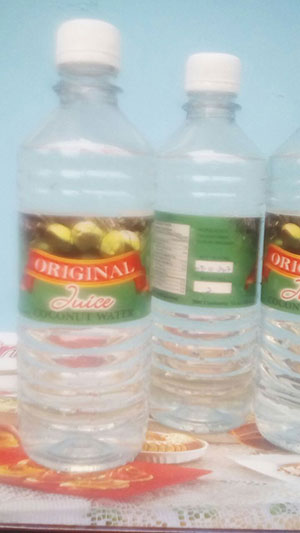Pomeroon businessman, Nateram Ramnanan and his award-winning, value-added product
By Gibron Rahim
GUYANA’S coconut industry has seen an increase in production in recent years. With their myriad uses and undeniable health benefits, coconut products have taken a firm hold of local and international markets. Greater emphasis is being placed on value-added

production in an effort to diversify our country’s agriculture industry. In Region Two, where the Pomeroon is at the heart of regional and, by extension, national production, entrepreneurs have taken steps to take advantage of agro-processing to create finished products from coconut. Among these entrepreneurs is Nateram Ramnanan, known popularly as ‘Juiceman’, owner of the Original Juice Centre.
Ramnanan produces bottled coconut water at his facility on the banks of the Pomeroon River. The venture had very humble beginnings. He stated that he originally had only two employees involved in the process. Today, he employs 15. He admits that he had not anticipated the kind of response the coconut water he produces would have had in the beginning. “Locally, I did not believe that coconut water could be so, but when I got more into it I saw that coconut water had potential,” he said.
His realisation led him to invest further, not just financially, but in terms of training as well. He credited Sterling Products Limited as being among the numerous organisations that had come forward to provide help. “Sterling Products had sent people to train us to know how to do the processing,” he said. The company also acts as distributor for Original Juice coconut water.

Required Expertise
Expertise is crucial to the production of the bottled coconut water as there are numerous conditions that must be met. “Coconut water is a delicate product,” Ramnanan explained. “It’s not the way that you can only cut and put into bottles. There’s [sic] many other stages you have to go through.” There are many steps of sanitation and those that follow food and drug regulations, including standards of the International Organization for Standardization (ISO).
Ramnanan took the time to explain some of the stages in the process, which he said was a complex one. The first step is, of course, acquiring the coconuts themselves. They are sourced from the farmers of the Pomeroon. “They have to be to a standard also,” Ramnanan said. “[They must be] at an age. Not too hard. Not too soft. Slight jelly.” Testing of the sugar content of some coconuts is also done to ensure the quality of the coconut water. A refractometer that measures the BRIX (sugar content of a water solution) is used for this purpose. The coconuts have to be handled carefully as well. “From the time you reap the coconut, you have to rope it down or don’t let it touch the ground,” he explained. “You have to transport it, either by boat or truck, under highly clean conditions.”

The coconuts have to be washed in a solution containing certain chemicals to sterilise them once they arrive at the processing facility. They are then dried. It is then time for the process of cutting. Ramanan had to acquire specialised equipment made of food grade stainless steel for processing and the blades used for cutting are amongst them. The workers also have an important role to play. “Workers have to be highly hygienic,” he said. They cannot wear jewellery such as rings and they must also be in good health and gloves and mouth guards are used to prevent any kind of contamination. The BRIX of the coconut water is monitored throughout the process. Once the coconut water is bottled, there is a necessary stage they must undergo before being placed in stainless steel cold storage under careful conditions: the bottles must be placed in an ice bath.
They spend 15 minutes in the ice bath at a certain temperature. Positive reaction to the product The local reaction to the bottled coconut water has been positive, according to Mr. Ramnanan. “From Guyanese, I have a good response because people are drinking the coconut water,” he said simply. He acknowledges that bottled coconut water costs more than soft drinks. Nevertheless, “people are coming for the coconut water,” he said. Ramnanan is also open to reaching beyond Guyana’s borders with his coconut water. “I am there for the future, for the international market, because the business speaks for itself,” he said emphatically. “I have to use whatever resources come from my business.” He has fully invested in this business and seen it grow. “I’m seeing future at the head of this,” he said.
This investment in the future that Ramnanan has done is already bearing fruit. At last year’s inaugural Coconut Festival, he revealed that Original Juice was the recipient of numerous awards and Ramnanan himself was awarded by the Guyana Manufacturing & Services Association Limited (GMSA) in 2011 for his contributions to agro-processing in Guyana. He has been able to travel to locations as varied as Las Vegas and Chicago. He has been part of a showcase of Guyanese products at the SIAL Agricultural Trade Show held in Toronto and Montreal.
Other products
Ramanan expressed his interest in finding uses for the by-product of the coconut processing, the details of which he is keeping under wraps. He also spoke about the usability of the raw materials from the coconut itself. It is indeed true that coconuts can be used to produce oil and milk as well as butter, cream and flour. The shell and leaves can be used in craftwork.
Indeed, the humble coconut has proven itself to be a versatile player in Guyana’s non-traditional crop industry. And from Nateram ‘Juiceman’ Ramnanan’s success so far with the agro-processing of coconuts, Guyana’s agricultural future will benefit from value-added production. This industrial momentum that is building up can only go forward toward a brighter future for Guyana.




.jpg)









